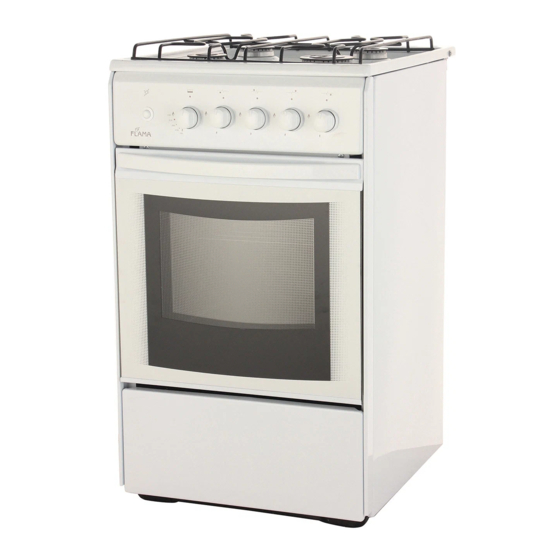Indesit MVK5V21RF S Podręcznik - Strona 22
Przeglądaj online lub pobierz pdf Podręcznik dla Piekarnik Indesit MVK5V21RF S. Indesit MVK5V21RF S 36 stron.

Precautions and tips
! This appliance has been designed and manufactured in
GB
compliance with international safety standards.
The following warnings are provided for safety reasons
and must be read carefully.
General safety
•
The glass ceramic hob is resistant to temperature
fluctuations and shocks. It is, however, wise to
remember that blades or cooking utensils may ruin the
surface of the hob. If this happens, remove the plug of
the cooker from the electricity socket and contact an
authorised Technical Assistance Centre in order to
request original spare parts. Failure to comply with the
above may compromise the safety of the appliance.
•
The appliance was designed for domestic use inside
the home and is not intended for commercial or
industrial use.
•
The appliance must not be installed outdoors, even in
covered areas. It is extremely dangerous to leave the
appliance exposed to rain and storms.
•
Do not touch the appliance with bare feet or with wet or
damp hands and feet.
• The appliance must be used by adults only for the
preparation of food, in accordance with the
instructions outlined in this booklet. Any other use
of the appliance (e.g. for heating the room)
constitutes improper use and is dangerous. The
manufacturer may not be held liable for any
damage resulting from improper, incorrect and
unreasonable use of the appliance.
•
The instruction booklet accompanies a class 1
(insulated) or class 2 - subclass 1 (recessed between 2
cupboards) appliance.
•
Keep children away from the oven.
•
Make sure that the power supply cables of other
electrical appliances do not come into contact with the
hot parts of the oven.
•
The openings used for the ventilation and dispersion of
heat must never be covered.
•
Always use oven gloves when placing cookware in the
oven or when removing it.
•
Do not use flammable liquids (alcohol, petrol, etc...)
near the appliance while it is in use.
•
Do not place flammable material in the lower storage
compartment or in the oven itself. If the appliance is
switched on accidentally, it could catch fire.
•
Always make sure the knobs are in the
the appliance is not in use.
22
•
When unplugging the appliance, always pull the plug
from the mains socket; do not pull on the cable.
•
Never perform any cleaning or maintenance work
without having disconnected the appliance from the
electricity mains.
•
If the appliance breaks down, under no circumstances
should you attempt to repair the appliance yourself.
Repairs carried out by inexperienced persons may
cause injury or further malfunctioning of the appliance.
Contact Assistance.
•
Do not rest heavy objects on the open oven door.
•
The appliance should not be operated by people
(including children) with reduced physical,
sensory or mental capacities, by inexperienced
individuals or by anyone who is not familiar with
the product. These individuals should, at the very
least, be supervised by someone who assumes
responsibility for their safety or receive
preliminary instructions relating to the operation of
the appliance.
•
Do not let children play with the appliance
•
If the cooker is placed on a pedestal, take the neces-
sary precautions to prevent the cooker from sliding
off the pedestal itself.
Disposal
•
When disposing of packaging material: observe local
legislation so that the packaging may be reused.
•
The European Directive 2002/96/EC relating to Waste
Electrical and Electronic Equipment (WEEE) states that
household appliances should not be disposed of using
the normal solid urban waste cycle. Exhausted
appliances should be collected separately in order to
optimise the cost of re-using and recycling the
materials inside the machine, while preventing potential
damage to the atmosphere and to public health. The
crossed-out dustbin is marked on all products to
remind the owner of their obligations regarding
separated waste collection.
Exhausted appliances may be collected by the public
waste collection service, taken to suitable collection
areas in the area or, if permitted by current national
legislation, they may be returned to the dealers as part
of an exchange deal for a new equivalent product.
All major manufacturers of household appliances
participate in the creation and organisation of systems
for the collection and disposal of old and disused
appliances.
•
position when
